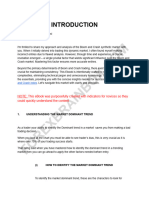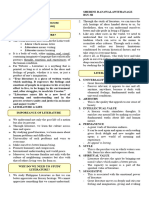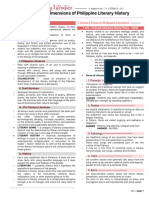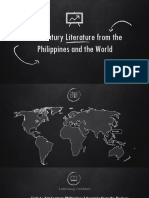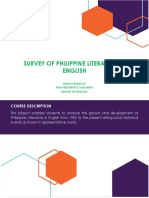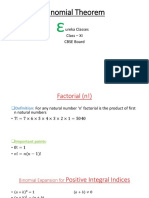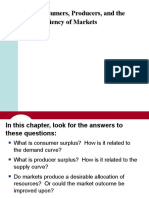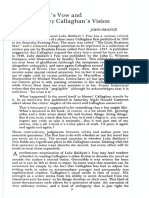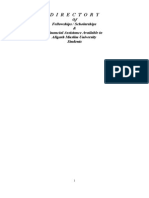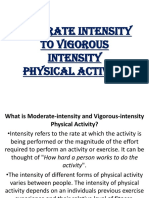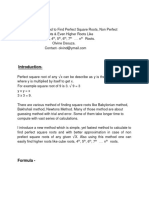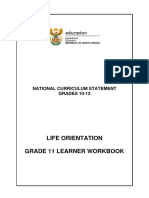Phil Lit
Phil Lit
Uploaded by
KYRAH MAE NICOLE DELACIONCopyright:
Available Formats
Phil Lit
Phil Lit
Uploaded by
KYRAH MAE NICOLE DELACIONOriginal Description:
Original Title
Copyright
Available Formats
Share this document
Did you find this document useful?
Is this content inappropriate?
Copyright:
Available Formats
Phil Lit
Phil Lit
Uploaded by
KYRAH MAE NICOLE DELACIONCopyright:
Available Formats
SURVEY OF PHILIPPINE LITERATURE ● Cultural Function- Literature orients us to
the traditions, folklore, and arts of our ethnic
Literature groups’ heritage. Literature preserves entire
● It comes from the Latin word “LITERA” cultures and creates an imprint of the
which literally means an acquaintance with people's way of life for others to read, hear,
letters. and learn.
● It is a body of literary productions, either ● Educational Function- Literature teaches us
oral, written,or visual, containing imaginative many things about the human experience.
language. Literature is used to portray the facets of life
● It is a language in use that provides insights that we see and those that we would never
and intellectual stimulation to the reader. dream of seeing. Literature, therefore, is a
● is a product of a particular culture that conduit for the chance to experience and
concretizes man’s array of values, feel things where we can learn things about
emotions, actions, and ideas. life.
● is an art that reflects the works of ● Historical Function- Ancient texts,
imagination, aesthetics, and creative writing illuminated scripts, stone tablets, etc. keep a
that are distinguished for the beauty of style record of events that happened in the place
or expression, as in fiction, poetry, essays, where they originated. Thus, they serve as
or drama, from scientific treatises and works time capsules of letters that are studied by
that contain positive knowledge. scholars and researchers today.
● significant human experience through the
form of writing. LITERARY STANDARDS
1. Artistry – a sense of beauty
Role of Literature 2. Intellectual value stimulates readers’
1. Literature helps us express ourselves thought.
2. Literature helps us learn new facts 3. Suggestiveness -the emotional appeal to
3. Literature teaches us about history and literature.
culture 4. Spiritual value- is the ability to inspire
4. Literature helps us to understand other readers by bringing out values and
points of view principles.
5. Literature makes us critical thinkers 5. Permanence - it can be read again and
6. Literature reflects what’s happening in the again as each reading gives new
world satisfaction and fresh insights
7. Literature is enjoyable 6. Universality – literature appeals to
everyone.
FUNCTIONS OF LITERATURE 7. Style – this is the unique way in which a
● Entertainment Function- Known as writer sees life and forms his ideas and
“pleasure reading”. In this function, literature expression.
is used to entertain its readers. Literary
works are consumed for the sake of one’s
enjoyment. History of Literature
● Social and Political Function- Literature The Pre-Colonial Period (BC-1564)
shows how society works around them. ● This existed before the Spanish occupation
Literature helps the reader ”see” the social in the 1500s.
and political constructs around him/her and ● It is oral in nature and is full of lessons and
shows the state of the people and the world ideas about life, its blessings, and its
around him/her. consequences.
● Ideological Function- Literature shapes our ● The sources are usually the local native
way of thinking based on the ideas of other town folk.
people. Literature also displays a person’s ● It contains ideas from birth to the grave.
ideology placed in the text consciously and
unconsciously. Forms
● Moral Function- Literature may impart moral
values to its readers. The morals contained 1.ORAL LITERATURE
in a literary text, whether good or bad, are a. Riddles b. Proverbs
absorbed by whoever reads it, thus helping
in shaping their personality. 2. FOLK SONGS
● Linguistic Function- Literature preserves the a. Lullabies d. Songs of Death
language of every civilization from where it b. Drinking Songs e. Religious Songs
originated. They are also evidence that a c. Love Songs
certain civilization has existed by recording
the language and preserving it through wide 3. Folk Tales
spans of time. a. Myths c. Fables
b. Legends d. Epics
The Spanish Period (1521-1898) While the Noli Me Tangere exposed the evils in
● The start of the Philippines’ more colorful society, the El Fili exposed those in the government
history took place on March 6, 1521, when and in the church.
Ferdinand Magellan docked on the shores
of Homonhon. Revolutionary Literature
● The Filipinos were then called “Ladinos”, ● Are exposés that sparked revolution and
meaning they were Latinized. resistance in the hearts of Filipinos. Most
● “Taga-Bayan” and “Taga-bundok/Taga- prominent figures in this type of literature
bukid”. are:Andres Bonifacio, Emilio Jacinto,
Apolinario Mabini, and Jose Rizal.
Forms Andres Bonifacio
1.Religious Literature ● Katungkulang Gagawin ng mga Anak ng
a. Pasyon c. Komedya Bayan (Obligations of our Countrymen) - an
b. Senakulo outline of obligations just like the Ten
Commandments; hence, it is likewise called
2. SECULAR OR NON-RELIGIOUS LITERATURE “Ang Dekalogo”
a. Awit c. Prose Narratives ● Ang Dapat Mabatid ng mga Tagalog (What
b. Korido Tagalogs Should Know) - an essay outlining
the basic tenets of Bonifacio’s ideas on
3. Propaganda Literature nationalism.
4. Revolutionary Literature Emilio Jacinto
● Liwanag at Dilim (Light and Darkness) - a
Propaganda Literature collection of essays on different subjects
● These were in the forms of satires, like freedom, work, faith, government, and
editorials, and news articles that aimed to love of country.
attack the Spanish rule. Apolinario Mabini
● The Propaganda trinity is composed of Dr. ● El Desarollo y Caida de la Republica
Jose Rizal, Marcelo H. Del Pilar, and Filipina (The Rise and Fall of the Philippine
Graciano Lopez Jaena. Republic) - this essay highlights the
establishment of the Philippine Republic
Propaganda Literature and its subsequent doom due to disunity
Graciano Lopez Jaena among the Filipinos.
● Fray Botod - one of his works written in Publications
Jaro, Iloilo in 1876, si years after the Cavite ● El Heraldo de la Revolucion(Herald of the
Revolt attacking the friars in the Philippines. Revolution) - This is the Official Newspaper
He exposed how some of the friars were of the Revolutionary Government of
greedy, ambitious, and immoral. Aguinaldo.
● La Hua Del Fraile (The Child of the Friar) ● La Independencia (Independence) - an
and Everything is Hambug (Everything is a independent newspaper founded and edited
mere show) - Here, Jaena explains the by General Antonio Luna.
tragedy of marrying a Spaniard. ● La Republica Filipina (The Philippine
Marcelo H. Del Pilar Republic) - a private newspaper edited by
● Caiigat Cayo (Be Slippery as an Eel) - a Pedro Paterno
humorous and sarcastic dig in answer to Fr. ● La Libertad (Liberty) - another private
Jose Rodriguez’s word “Caiingat kayo” newspaper edited by Clemente Zulueta.
● Dasalan at Tocsohan (Prayers and Jokes) -
similar to cathecism but sarcastically done
against the parish priests, published in The American Period(1900-1942)
Barcelona in 1888. ● The Philippines had a great leap in
● Ang Cadaquilaan ng Dios (God’s Education and Culture.
Goodness) - published in Barcelona, it was ● The use of English alongside Filipino was
also like a cathecism sarcastically aimed practiced.
against the parish priests but also contains ● The literature during the American period
a philosophy of the power and intelligence was considered as imitative of American
of God and an appreciation for love and model.
nature. Forms
Dr. Jose Rizal 1. Poetry - poetry under the American rule still
● Noli Me Tangere - this was the novel that followed the style of the old, but had
gave spirit to the propaganda movement contents that ranged from free writing to
and paved way to the revolution agains societal concerns under the Americans.
Spain. 2. Drama - was usually used in the American
● El Filibusterismo - this is a sequel to the Noli period to degrade Spanish rule and to
Me Tangere. immortalize the heroism of the men who
fought under the Katipunan.
3. Remakeovels - took up Dr. Jose Rizal’s Forms
portrayal of social conditions by colonial
repression. ● Poetry - nationalism, country, love, life in the
Poetry barrios,
Jose Corazon de Jesus (1832-1896) 1. faith, religion, and the arts.
● Popularly known as “Batute” created his 2. Fiction - Many short stories are written in
own generation with his first book of poems. this period.
● Mga Gintong Dahon (1920) - were poems 3. Drama - experienced a lull.
pre-occupied with such non-traditional 4. Newspapers - new form of writings that
themes as passion-slaying, grief- induced, came out during this period and were
insanity, and lover’s suicide. journalistic in nature.
● Sa Dakong Silangan (1928) - returned to 5. Essays - were composed to glorify the
the song form, retelling the history of Filipinos and at the same time, to
Philippines under Spain, the coming of the figuratively attack the Japanese.
U.S. under the guise of friendship to take
over from Spain.
Drama Contemporary and Post-Independence Period
Severino Reyes(1861-1942) (1946-Present):
● Spearheaded a movement to supplant the ● In the 21st century, there are a lot of literary
komedya with a new type of drama, the innovations that are adapted and created by
“Sarsuwela” , a Filipino adaptation of the Filipinos.
Spanish Zarzuela. ● Nowadays, even those who do not have any
● Walang Sugat (1902) - is a sarsuwela significant literary background make their
(drama in the form of singing) drawn from own way using the freedom that they have
the period of Revolution, depicting the to write and to express.
cruelty and corruption of friars and the ● There are a lot of new forms from the basic
heroism of the soliders of the Katipunan. genres of literature; thus, proving how far
Drama the literature in the Philippines has gone
Other successful sarsuwelas: and how far it will go on from here.
● Hindi Aco Patay (1903) by Juan Matapang
Cruz
● Kahapon, Ngayon, at Bukas (1903) by Role of Literature
Aurello Tolentino - is an allegorical ● Literature helps us to express ourselves and
presentation of the history of the national learn new facts.
struggle and how the U.S. started the ● Literature teaches us about history and
Philippine Revolution. culture.
● Tanikalang Guinto (1902) by Juan Abad ● Literature helps us to understand other
(1872-1932) - is about Liwanag and points of view.
K’Ulayaw lovers who stand for freedom and ● Literature makes us critical thinkers and
the Filipino. reflects what’s happening in the world.
Remake Novels ● Literature is enjoyable.
● Gabriel Beato Francisco (1850-1935) - is
best known for his trilogy of Fulgencia Essence and Function
Galbillo (1907), Capitan Bensio (1907), and
Alfaro (1909), depicting the 30 years of Essence of Literature
colonial repression by the Spanish rule ● Provides readers a historical knowledge of
● Inigo Ed. Regaldo (1888-1976) Madaling the country by reflecting on the past.
Araw (1909) was his first novel showing the ● Develops and enhances our skills in
complex interrelations of issues and people communication, vocabulary, and reading.
in contemporary Philippine society. ● Encourage us to become more expressive
● Juan Lauro Arsciwals (1889-1928) - and creative.
Lalaking Uliran o Tulisan (1914), allusion to ● Gives readers inspiration for better life.
the colonial law that branded Filipino Function of literature
patriots as bandits. ● Literature educates people in the society.
● Literature expresses people's culture.
● Literature is used to entertain people.
The Japanese Period (1941-1945) and The ● Literature is used to influence people in the
Republic (1946-1985) society
● The Philippine literature came into a halt. ● Literature is used to develop language.
● The use of the English language was ● Literature is used to liberate people mentally
forbidden, and the use of the Filipino and physically.
language was mandated under the
Japanese rule.
Literary Standards- A particular literary piece must present opinions. It is a literary medium that
possess seven literary standards in order to be corresponds closely to everyday speech
called a peerless epitome of artwork capable of patterns and is used to provide detailed
enduring the inexorable gusty tides of alteration. descriptions of ideas, objects, or situations.
Types of prose:
● Artistry- a quality which appeals to our Biography
sense of beauty. Autobiography
● Intellecctual beauty- Literature stimulates Folktale
critical thinking that enriches mental Myth
processes of abstract and reasoning, Legend
making man realize the fundamental truths Drama
of life and its nature. Fable
● Suggestiveness- Literature unravels and Parable
conjures man’s emotional power to define Novel
symbolisms, nuances, implied meanings, Short Story
images and messages, giving and evoking Essay
visions above and beyond the plane of
ordinary life and experience. ● Poetry- Is a literary work expressed in
● Spiritual Value- Literature elevates the spirit verse, measure, rhythm, sound, and
and the soul and this has the power to imaginative language and create an
motivate and inspire, drawn from the emotional response to an experience,
suggested morals or lessons of the different feeling, or fact.
literary genres. Example: First, a Poem Must Be Magical by José
● Permanence- a great literary work endures García Villa
and can be read again as each readings
givesfresh delights and new insights. It 3. GENRE
should not be ephemeral or merely a
passing hype tothe audience; it should be ● Fiction- Is a narrative in prose that shows an
long-lasting imaginative recreation and reconstruction of
● Universality- a great literary work is timeless life and presents human life in two levels:
and timely. It is forever relevant, itappeals to the world of objective reality made up of
one and all, anytime, and anywhere human actions and experiences, and the
because it deals with an array of individual's world of subjective reality dealing with
perceptions as well as orientations toward human apprehension and comprehension
fundamental truths and universalconditions. categorizes either a novel or short story.
● Style- it is peculiar way in which a writer ● Poetry- Is a patterned form of verbal or
sees life, form his or her ideas expresses written expression of ideas in concentrated,
them.Great works are marked as much by imaginative, and rhythmical terms that often
their memorable substances as by their contain the elements of sense, sound, and
distinctivestyle. structure.
● Essay- Is a prose composition of moderate
Classification of literature length that presents a tentative exploration
1. STRUCTURE or evaluation of a subject and thus explains
● Fiction- Is a literary work of imaginative a viewpoint or anything that can be said on
narration, either oral or written, fashioned to a particular subject.
entertain and to make the readers think, and Example: Philippines a century hence (Filipinas
more so, to feel. dentro de cien anos) by Jose Rizal
Example: Noli Me Tángere (Touch Me Not) by José ● Drama- Is a composition in prose form that
Rizal presents story told entirely in dialogue and
● Non-fiction- Is a literary work of "real-life" action, and written with the intention of its
narration or exposition based on history and eventual performance before an audience.
facts whose main thrust is an intellectual Example: Wanted: A Chaperon by Wilfrido
appeal to convey facts, theories, Ma. Guerrero
generalizations, or concepts about a
particular topic.
Example: An Eyewitness History People Power: Classification of Literary Approaches
The Philippine Revolution of 1986 by Monina 1. Formalistic or Literary Approach- Literature
Allarey Mercado and Francisco S. Tatad is viewed intrinsically, independent of the
author, age, or any other extrinsic factor.
2. FORM Examples:
● ProseIs a literary work that is spoken or The Rood not Taken by Robert Frost 1984 by
written within the common flow of language George Orwell The Great by Gatsby
in sentences and paragraphs that give
information, relate events, express ideas, or
2. Moral or Humanistic Approach- Literature is ● Fiction- is a literary genre that includes
viewed to discuss man and its nature. It stories created from the imagination rather
presents man as essentially rational; that is, than based on real events. It can
endowed with intellect and free will; or that encompass a wide range of subgenres,
the piece does not misinterpret the true including science fiction, fantasy, romance,
nature of man. mystery, and more.
Example: The Little Prince – Antoine de ● Poetry- is rhythmic writing that is meant to
Saint-Exupery express or elicit an emotional response.
Poetry often draws heavily on imagery and
3. Historical Approach- Literature is seen both figurative language to appeal to the reader's
as reflection and product of the times and imagination. It is usually arranged in lines
circumstances in which it was written. It and stanzas and usually shorter in length
operates on the premise that the history of a than other genres of literature.
nation has telling effects on its literature and ● Poetry has two sub-genres:
that the piece can be better understood and ● Lyric poems- express emotions.
appreciated if one knows the times For example: Sa Dalampasigan by Teodoro
surrounding-its creation. A. Agoncillo
Example: Grease by Randal Kleiser ● Narrative poems- tell stories.
For example: The Return by Jose Corazon
4. Sociological Approach- Literature is viewed De Jesus
as the expression of man within a given ● Essay- an analytic, interpretative, or critical
social situation which is reduced to literary composition usually much shorter
discussions on economics. and less systematic and formal than a
Examples: -dystopian novels like Brave dissertation or thesis and usually dealing
New World by Aldous Huxley or Animal with its subject from a limited and often
Farm by George Orwell, personal point of view.
● Sub classifies as:
5. Cultural Approach- Literature is seen as one ● FORMAL - "serious purpose, dignity, logical
of the manifestations and vehicles of a organization, length,
nation’s or race’s culture and tradition. It ● "INFORMAL - "the personal element
includes the entire complex of what goes (self-revelation, individual tastes and
under “culture” - the technological, artistic, experiences, confidential manner), humor,
sociological, ideological aspects; and graceful style”
considers the literary piece in the total ● Drama- is the portrayal of fictional or non-
cultural milieu in which it was born. fictional events through the performance of
Example: A sample of this is language, one written dialog. It can be performed on stage,
of the many indicators of culture. on film, or on the radio. Dramas are typically
called plays, and their creators are known
6. 6. Psychological Approach- Literature is as “playwrights” or “dramatists.
viewed as the expression of “personality” of ● Short Story- An invented prose narrative
inner drives of “neurosis”. It includes the shorter than a novel usually dealing with a
psychology of the author, of the characters, few characters and aiming at unity of effect
and even the psychology of creation. It has and often concentrating on the creation of
resulted in an almost exhausting and mood rather than plot.
exhausive “psychological analysis” of
characters, of symbols and images, of Literature in the Early Period of the Philippines
recurrent themes, and others.
Example: Frederick Crews's reading in The Macario’s Noche Buena
Sins of the Fathers: Hawthorne's by: Tarcila Malabanan Katigbak
Psychological Themes (1966). ● Tarcilla Malabanan Katigbak (1891-1981)
-She was born in Lipa, Batangas. She was
7. Impressionistic Approach- Literature is the daughter of Servando Malabanan and
viewed to elucidate “reaction-response” Romana Librea. She was married by a
which is considered as something very notable writer, Jose Ma.Katigbak.
personal, relative, and fruitful. ● They had one son, he is Augosto Jaime M.
Unconditioned by explanations and often Katigbak, Sr. Tarcila passed away in 1981,
taking the impact of the piece as a whole, it at age 90.
seeks to see how the piece has ● She wrote short stories that created images
communicated. in simple English such as the Estudiante
Example: Mrs. Dalloway by Virginia Woolf and Macario’s Noche Buena.
Characters
● Macario - he is known as a famous thief and
a chief of a gang who hunted across the
country.
● Merchant - the man riding a horse with ● Social responsibility- The essay highlights
baskets containing groceries and toys. the idea that an educated Filipino should
Setting have a sense of social responsibility and be
● Time - December 24th, Christmas eve, actively engaged in the betterment of
“Noche Buena” society.
● Place - In the shore of Laguna De Bay ● Culture identity- The essay stresses the
Point Of View need for Filipinos to understand and
● Third person point of view appreciate their own culture, language, and
Conflict history. An educated Filipino should not
● Man vs himself neglect their cultural roots in favor of foreign
Theme influences.
● Memories ● Character and values- Education should not
only focus on academic knowledge but also
Francisco F. Benitez on the development of character and
● the founder and first editor of the Philippine values. An educated Filipino should exhibit
Journal of Education . One of the best he qualities like integrity, honesty, and a strong
wrote is What Is An Educated Filipino which work ethic.
discussed the change in our social life,
change in education, practical activities as
well as artistic speech and behavior. Jose Villa Garcia (1908-1997)
● wrote "What Is an Educated Filipino?" ● Born: August 05, 1908 | Manila Singalong
during a period of significant educational District
reforms in the Philippines under American ● Death: February 07, 1997
colonial rule. ● Filipino poet, literary critic, short story writer,
● Benitez sought to define the qualities and and painter. He used the penname
values of an educated Filipino to provide Doveglion which was derived from "Dove,
clarity for educators and students. Eagle, Lion" that was based on the
● awards Doctor of Laws (honoris causa): characters he derived from himself.
Benitez was conferred with honorary Doctor ● He is known to have introduced the
of Laws degrees by prestigious institutions, "reversed consonance rhyme scheme" in
including the University of the Philippines writing poetry, as well as the extensive use
(UP) and the University of Santo Tomas of punctuation marks—especially commas,
(UST) for his significant contributions to which made him known as the Comma
education and literature. Poet.
● Presidential Medal of Merit: Benitez
received the Presidential Medal of Merit in The Author and his work “ The Fence”
1947 for his exemplary service and ● The characters in the story have strong
dedication to the nation, especially during personality like the writer itself he has
the challenging times of World War II. strong and brave personality.
● An expository style of writing is more formal ● In the story “The Fence” there is a bit
and straightforward, so the casual language similarity in the writer’s life focusing on the
or slang that you would use with friends is separation of the couple. Jose Garcia is
not acceptable. separated with his wife and had kids.
● Non fiction prose- any literary work that is ● The Fence was written during American
based mainly on fact, even though it may Colonial Period
contain fictional elements. Examples are the ● It was published on December 24,
essay and biography. It is a recount of 1927-Philippines Free Press Summer 1932
real-life events. in USA
● Oriental and Occidental symbolism- “The ● He was awarded the National Artist of the
Oriental excels in reflective thinking: he is a Philippines title for literature in 1973, as well
philosopher. The Occidental is a doer; he as the Guggenheim Fellowship in creative
manages things, men and affairs. The writing by Conrad Aiken.
Filipino of today needs more of this power to
translate reflection into action.” Characters
● This symbolism highlights the need for a ● Aling Biang – unforgiving woman who was
balanced education that combines both betrayed by her husband with her neighbor.
reflective thinking and practical application. ● Aling Sebia – a widow/ Aling Biang's
● Nationalism- Benitez emphasizes the neighbor who has not seen a feeling of
importance of instilling a sense of national remorse having caught with her neighbor's
pride and love for one's country in an husband.
educated Filipino. He believes that ● Iking – Aling Biang's son who wanted his
education should help individuals appreciate mom to reconcile with their neighbor
their Filipino heritage and culture.
● Aling Sebia's Daughter – a healthy, ugly girl ● The theme of the story Footnote to Youth
who is good in playing guitar that made means that people will always go with their
Iking to fall in love. feelings without hesitations they will do
● Aling Biang's husband - a man who left anything to get what they want specially the
unsettled with his wife youth and then regretting it at the end.
Point of View
● The story is in the Third Person Point of The Historical Context of Philippine Literature
View. The narrator is not part of the story during the Middle Period 1930-1960
but the he let us know exactly how the ● The Filipino writers began in English
characters thought, attitude and feeling. We language by mastering vocabulary ,learning
learn about the characters through this the mechanics of grammar , and imitating
outside. established western Writers.
● By 1925,the extent and quality of writing has
Settings greatly improved and perhaps it is wrong to
● Roadside – It is the place where Aling Sebia say that the early period of Philippine
and Aling Biang stood alone, neighborless Literature ended in 1930
but for themselves. The boy Iking was not ● Leopoldo Yabes , a prominent Rizalist and
allowed to play by the roadside; for if he did, prolific writer, called the year 1930-1944 the
he would not know were on the other side of “most productive”of distinctive work in
the fence
● Nipa house of Aling Biang – It is the place THE PHIILIPPINE COMMONWEALTH
where Iking was born. It is also the place GOVERNMENT
where Iking keeps on listening to the ● During this time, writers began to explore
daughter of Aling Sebia while playing guitar. the idea of searching for a national identity
● Nipa house of Aling Sebia – It is the place that form the organization of Philippine Book
where the daughter of Aling Sebia plays Guild .This organization aimed for a
guitar purpose to create a wider reading that will
be available for Filipino writers by printing
Conflict low-cost books. One of these books is
● Man vs Man Arturo Rotors “The wound and Scar”
Theme 8 Major Styles of writing in the Middle Period
● Hatred ● Characteristics of literature
● Recurrent Subject matter or themes
● Recurrent settings
Footnote to Youth ● Recurrent characters
● use of Local colors
CHARACTERS ● About the WWII or Japanese Occupation
● Dudong - main character of the story who ● Stylish Characterestics
got married at the age of 17 ● Reflects Filipino customs ,traditions
● Teang - regretted marrying at an early age
● Lucio - Teang's other suitor who got married FAMOUS ESSAYISTS
after she did and who's childless until now ● Salvador Lopez
● Blas - Dodong and Teang's oldest son who ● Freancisco Icasiano
followed their footsteps in the end. Blas ● Pura Santillan Castrence
contemplated to marry Tona when he was ● Maria Kalaw Katigbak
18 ● Jose Laurel
● Tona - woman whom Blas wants to marry ● Vicente Hilario
● Federico Mangahas
POINT OF VIEW ● Godofredo Rivera
● the point of view used was the omniscient ● Leopoldo Yabes
limited wherein the author tells the story in
third person. FAMOUS FICTIONIST
● Manuel Arguilla
SETTING ● Delfin Fresnosa
● the setting is in the rural area where life is ● Nick Joaquin
simple ● Stevan Javellana
● Nestor Vicente Gonzales
THEME ● Estrella Alfon
● Man vs Himself ● Edith Tiempo
● Man vs Man ● Alejandro Roces
● Kerima Polotan Tuverta
Famous Poets ● LABANG- the carabao in the story leon’s
● Angela Manalang Gloria favorite friend in the province
● Maximo Ramos
● Jose Garcia Villa POINT OF VIEW
● Ricaredo Demetillo ● First person, since Baldo is the one
● Carlos Angeles narrating the story
● Bienvenido Santos
● Conrado Pedroche SETTING
● Edith Tiempo ● The setting of the story was in Bario
Nagrebcan at bauang La Union during the
FAMOUS PLAYWRIGHTS 1940's
● Wilfrido Maria Guerrero CONFLICT
● Wilfrido Nolledo ● Man vs Man
● Severino Montano ● Man Vs. Society
● Alberto Florentino Theme
● Jesus Peralta ● The theme of this story is that Love that
Maria and Leon go forward in what ever
HOW MY BROTHER LEON BROUGHT HOME A struggle to come will be ignored by them.
WIFE By Manuel Arguilla GENRE
● Manuel E. Arguilla (1911-1944) was a ● Fiction
Filipino writer in English, patriot, and martyr
● He was born in Nagrebcan, Bauang, La STYLE
Union, and had a deep connection to his ● Descriptive , the author uses vivid imagery
Ilocano roots. when depicting every scene in the story.
● Arguilla's writings were known for their local
color, capturing the essence of Ilocano life The Cheiftest Mourner by AIDA RIVERA FORD
and culture. AIDA RIVERA FORD
● He studied at the University of the ● Born: January 22, 1926 in Jolo, Sulu
Philippines, where he was involved in the ● Parents: Pablo Rivera and Lourdes
U.P. Writer's Club and Literary Apprentice. Consunji
● He married Lydia Villanueva, another ● Husband: Donald Ford, married in 1958
talented writer in English. ● 1949: Graduated as Cumlaude with the
● Arguilla taught creative writing at the Degree in AB English at Siliman University
University of Manila and worked at the Negros Occidental.
Bureau of Public Welfare. ● 1954: Acquired her Master’s Degree at
● He secretly organized a guerrilla intelligence University of Michigan.
unit against the Japanese during World War ● 1980: Founded the Learning Center of the
II. Arts in Davao City
● 1993: The school was renamed as
PERIOD
● Modernism The Cheiftest Mourner
● The meaning of the “Cheiftest Mourner” is
MEANING OF THE PIECE the one who grieves the most.
● This short story highlights the value of ● In the story it was not known to who really
togetherness and the value of family.It was the cheiftest mourner. Was it Aunt
speaks about loving and caring for each of Sophia , the legal wife? Or was it Esa, the
the member of the family. mistress, who was there for the poet on his
hardest time?
CHARACTERS
● BALDO- the younger brother who narrates Point of View
the storyt ● FIRST PERSON POINT OF VIEW- The
● LEON- the one who went back to province Chieftest mourner is narrated in a
from manila to introduce his wife to his first-person point of view since the narrator
family was able to narrate the rivalry between the
● MARIA- the civilized wife of leon from legal wife and the mistress, as well as the
Ermita Manila appreciative to see the lives conflict and theme of the story. In the story,
in province the pronouns I, me, and my, were used
● FATHER- challenged maria on her way to which is an indication that it uses
their home ,his leg was in jured during the first-person pov.
revolutionary war.
● MOTHER- a typical Ilocana
● CA CELIN-driver of caratela
● AURELIA- sister of leon and baldo
Characters
● The Niece- She was the author itself and is
the Niece of Aunt Sophia
● The Poet- Husband of Aunt Sophia, a
famous and a great poet.
● The Wife- Aunt Sophia is the loyal and a
patient wife of the poet.
● The Mistress- Esa was the other woman of
the poet.
Setings
● Aunt Sophia’s House- The house where
she and her niece stays.
● The Poet’s New Home- The place where
the poert and her mistress stays
● The Chapel- The place where the funeral of
the poet takes place
● School- The school where the niece is
attending
●
You might also like
- The Secret of Boom and Crash Trading Sniper EntryDocument22 pagesThe Secret of Boom and Crash Trading Sniper Entryadvancedt24100% (1)
- EL 111 MOdules CompleteDocument158 pagesEL 111 MOdules CompleteKristine Bruzola SalditosNo ratings yet
- Operation & Service Manual: Model: 06-4035-3600 Hydraulic Service UnitDocument8 pagesOperation & Service Manual: Model: 06-4035-3600 Hydraulic Service UnitAlejo Guerra FernandezNo ratings yet
- 21st Century Literature ReviewerDocument4 pages21st Century Literature ReviewerJeremy PabloNo ratings yet
- 21st Century Literature 1st QuarterDocument31 pages21st Century Literature 1st QuarterLawrenceglenn DeguzmanNo ratings yet
- 1Q Day1 ReviewerDocument25 pages1Q Day1 ReviewerExcel BondocNo ratings yet
- Prelim Reviewer For 21st LitDocument18 pagesPrelim Reviewer For 21st LitGABA CALVIN JAMES P.No ratings yet
- 21st Century Literature 6Document3 pages21st Century Literature 6Loren nicole MonesNo ratings yet
- Bsee 34 ReviewerDocument6 pagesBsee 34 ReviewerShaina Leila Apolonio GarciaNo ratings yet
- LecNotes Phil-LitDocument3 pagesLecNotes Phil-LitAngelo Jude CobachaNo ratings yet
- CLPW HandoutsDocument4 pagesCLPW HandoutsJosh RamirezNo ratings yet
- 21st Century Literatures From The Philippines and The World: (WEEK 1)Document14 pages21st Century Literatures From The Philippines and The World: (WEEK 1)cristine SorianoNo ratings yet
- Phil Lit PrelimsDocument8 pagesPhil Lit PrelimsKathrine NobleNo ratings yet
- 21stc Lit Quarter 1 Lesson 1 1Document11 pages21stc Lit Quarter 1 Lesson 1 1alinabonaliahNo ratings yet
- Survey of Philippine Literature in English: LiteraDocument9 pagesSurvey of Philippine Literature in English: LiteraBeny Tawan100% (1)
- 21st PRE LIMS - COVERAGEDocument5 pages21st PRE LIMS - COVERAGEGlen Ruzzel ElleveraNo ratings yet
- Week 2 Part 1 - 21st CLPWDocument100 pagesWeek 2 Part 1 - 21st CLPWMarion April AlmoroNo ratings yet
- 21st Century Lit. HandoutsDocument12 pages21st Century Lit. HandoutsMaryrolyn DelgadoNo ratings yet
- Pointers For English 4Document6 pagesPointers For English 4baruelashyne44No ratings yet
- Week 1 21st Century LiteratureDocument7 pagesWeek 1 21st Century LiteratureVillavicencio KylaNo ratings yet
- Competency 1: Identify The Geographic, Linguistic, and Ethnic Dimensions of PhilippineDocument12 pagesCompetency 1: Identify The Geographic, Linguistic, and Ethnic Dimensions of PhilippineBIT INTERNATIONAL COLLEGE TALIBONNo ratings yet
- Module 1-21ST CENTURY LiteratureDocument12 pagesModule 1-21ST CENTURY LiteratureEdnalyn Barniza BrecioNo ratings yet
- DLP LO4 Various Dimensions of Philippine Literary History (S)Document28 pagesDLP LO4 Various Dimensions of Philippine Literary History (S)Juliana ChristineNo ratings yet
- 21ST Century Literature ReviewerDocument16 pages21ST Century Literature ReviewerlauronczidrikjeielNo ratings yet
- 21st Century Literatures From The Philippines and The World: Senior High SchoolDocument10 pages21st Century Literatures From The Philippines and The World: Senior High SchoolJehanie Abdulmalik50% (2)
- Popular Literature FinalDocument7 pagesPopular Literature FinalRutchell Mata DologuinNo ratings yet
- ?Q3 21st Cent Lit ReviewerDocument17 pages?Q3 21st Cent Lit ReviewerraikitesNo ratings yet
- Nature and Purpose of Literature: Prepared By: Ellaine B. PradoDocument26 pagesNature and Purpose of Literature: Prepared By: Ellaine B. PradoJanelleNo ratings yet
- 21st - Lesson 1Document40 pages21st - Lesson 1Soliman Micaela M.No ratings yet
- 1 - Society and Literature2 2 1Document19 pages1 - Society and Literature2 2 1Princess Liban RumusudNo ratings yet
- IMPORTANCE OF STUDYING PHILIPPINE LITERATURE Module 2Document4 pagesIMPORTANCE OF STUDYING PHILIPPINE LITERATURE Module 2michaeldaveperezzzNo ratings yet
- SHS - Q1 - Mod1 - 21st Century Literature Lesson 1 and 6 Version 3 PDFDocument23 pagesSHS - Q1 - Mod1 - 21st Century Literature Lesson 1 and 6 Version 3 PDFMaria Cailao50% (2)
- 21st Literature ReviewerDocument13 pages21st Literature ReviewerdenisearugayNo ratings yet
- Summary of All The Periods of The Philippine LiteratureDocument25 pagesSummary of All The Periods of The Philippine LiteratureRodel VillovinoNo ratings yet
- Survey of Philippine Literature in EnglishFirstSemSY2023 2024 AutosavedDocument29 pagesSurvey of Philippine Literature in EnglishFirstSemSY2023 2024 AutosavedDaisy Mae Tedlos100% (1)
- 21st Century Literature - MODULEDocument99 pages21st Century Literature - MODULEGeneDepps100% (1)
- 21st Century Literature ReviewerDocument3 pages21st Century Literature ReviewerMary claire GulipatanNo ratings yet
- WORLD LIT PrelimsDocument9 pagesWORLD LIT PrelimsDISTOR, JOSH GABRIELNo ratings yet
- Phil Lit Prelims ReviewerDocument8 pagesPhil Lit Prelims ReviewerPrincess Loise YtacNo ratings yet
- 3r6e5qu1i - LIT 101 MODULE 1 2023Document7 pages3r6e5qu1i - LIT 101 MODULE 1 2023altheadocuprintsNo ratings yet
- LITERATUREDocument25 pagesLITERATUREMaffyFelicianoNo ratings yet
- Teaching-Guide - 1Document6 pagesTeaching-Guide - 1maepaule06No ratings yet
- Jose Garcia Villa (Aug. 5, 1908 - Feb. 7, 1997)Document2 pagesJose Garcia Villa (Aug. 5, 1908 - Feb. 7, 1997)Rax RequintoNo ratings yet
- Phil. Litt. ETEEAP LectureDocument11 pagesPhil. Litt. ETEEAP LectureMarrean Campomanes Mindo AstreroNo ratings yet
- 21st LiteratureDocument49 pages21st LiteratureMark Lawrence VillanuevaNo ratings yet
- Hum 1-L1Document8 pagesHum 1-L1kaika kobayashiNo ratings yet
- 21st-Century-Literature - MODULE 1st QDocument99 pages21st-Century-Literature - MODULE 1st QSheryl PanesNo ratings yet
- 21 Century Literature From The World and The Philippines: 4 Quarter Week 1Document12 pages21 Century Literature From The World and The Philippines: 4 Quarter Week 1Rutchel100% (2)
- 21st Century Literature From The PhilippinesDocument107 pages21st Century Literature From The PhilippinesEllis BellNo ratings yet
- Geographic, Linguistic, and Ethnic Dimensions of Philippine Literary HistoryDocument15 pagesGeographic, Linguistic, and Ethnic Dimensions of Philippine Literary HistoryAlljhon Dave Joshua MagnoNo ratings yet
- English PDFDocument147 pagesEnglish PDFPrince AmazonaNo ratings yet
- Philippine Literary HistoryDocument25 pagesPhilippine Literary HistoryMatthew Brian UbacNo ratings yet
- 21st Century Lesson 1Document30 pages21st Century Lesson 1Norhainie OrintarNo ratings yet
- 21ST Century Literature Third QuarterDocument20 pages21ST Century Literature Third QuarterElvis Viernes100% (1)
- Phil Lit ModuleDocument46 pagesPhil Lit ModuleRod Anague EstolasNo ratings yet
- 21st Century Lit Lesson 1Document95 pages21st Century Lit Lesson 1Yma FeelNo ratings yet
- 1st QTR - 21st Century - Module 1Document29 pages1st QTR - 21st Century - Module 1Yanah Maristela PollescasNo ratings yet
- 21st Q1.1 2Document9 pages21st Q1.1 2jemimajoyceregondolaNo ratings yet
- Lit 1 ModuleDocument114 pagesLit 1 ModuleRegina Soon (Ren)No ratings yet
- PHILIPPINE-LITERARY-HISTORY (Teacher D)Document25 pagesPHILIPPINE-LITERARY-HISTORY (Teacher D)v2p4ff7ctfNo ratings yet
- Indigenous Cosmolectics: Kab'awil and the Making of Maya and Zapotec LiteraturesFrom EverandIndigenous Cosmolectics: Kab'awil and the Making of Maya and Zapotec LiteraturesNo ratings yet
- Group 6Document84 pagesGroup 6KYRAH MAE NICOLE DELACIONNo ratings yet
- ResearchDocument9 pagesResearchKYRAH MAE NICOLE DELACIONNo ratings yet
- Building and Enhancing ReviewerDocument7 pagesBuilding and Enhancing ReviewerKYRAH MAE NICOLE DELACIONNo ratings yet
- Lesson PlanningDocument3 pagesLesson PlanningKYRAH MAE NICOLE DELACIONNo ratings yet
- Annual Report: of The Secretariat of The Pacific Regional Environment ProgrammeDocument52 pagesAnnual Report: of The Secretariat of The Pacific Regional Environment ProgrammeDavid BriggsNo ratings yet
- Best Start Kindergarten Assessment: Literacy: A Parent's GuideDocument1 pageBest Start Kindergarten Assessment: Literacy: A Parent's Guidemich1984No ratings yet
- MCQS Int332 - Devops Virtualization and Configuration ManagementDocument46 pagesMCQS Int332 - Devops Virtualization and Configuration ManagementAbhishek KumarNo ratings yet
- Binomial Theorem: Ureka Classes Class - XI CBSE BoardDocument9 pagesBinomial Theorem: Ureka Classes Class - XI CBSE BoardAyash JainNo ratings yet
- True FalseDocument2 pagesTrue FalseCarlo ParasNo ratings yet
- Quijano-Solis Carlos J 201511 PHD ThesisDocument198 pagesQuijano-Solis Carlos J 201511 PHD ThesisshanthakumargcNo ratings yet
- Nadcap Customer Support Initiative (NCSI) For NewcomersDocument94 pagesNadcap Customer Support Initiative (NCSI) For NewcomersAli Mohsin100% (2)
- GSK Pakistan Annual Report 2021Document44 pagesGSK Pakistan Annual Report 2021SaadNo ratings yet
- Infosys PPT 13Document9 pagesInfosys PPT 13Durga Prasad SmartNo ratings yet
- CH 10 Material Transport SystemsDocument57 pagesCH 10 Material Transport SystemsrazansamaemehNo ratings yet
- 15 MW Kanfeng Hydropower ChinaDocument42 pages15 MW Kanfeng Hydropower Chinahumane28No ratings yet
- Consumers, Producers, and The Efficiency of MarketsDocument42 pagesConsumers, Producers, and The Efficiency of Marketspankaj_parmar98No ratings yet
- Introduction of JAVADocument12 pagesIntroduction of JAVARahul SinghNo ratings yet
- Luke Baldwin's Vow and Moriey Callaghan's VisionDocument13 pagesLuke Baldwin's Vow and Moriey Callaghan's VisionTú Quỳnh Nguyễn ĐặngNo ratings yet
- Assessment Diagnosis Outcome Interventions Rationanle EvaluationDocument3 pagesAssessment Diagnosis Outcome Interventions Rationanle EvaluationSheng Timbasal AbduraupNo ratings yet
- Computer BasicsDocument409 pagesComputer Basicsmukesh_kumar_470% (1)
- Space Frame StructuresDocument10 pagesSpace Frame StructuresvamshiNo ratings yet
- Scholarship GuideDocument55 pagesScholarship GuideIntikhabNo ratings yet
- November RevitionDocument3 pagesNovember RevitionRokaya fouadNo ratings yet
- Bright Wash-Safety Data SheetDocument8 pagesBright Wash-Safety Data SheetTariq khanNo ratings yet
- Electrochemical Polymerization of Aniline in Presence of Tio NanoparticlesDocument6 pagesElectrochemical Polymerization of Aniline in Presence of Tio NanoparticlesIndra JemainNo ratings yet
- 8 F 7 ADocument5 pages8 F 7 Aศิวาเวช อบมาNo ratings yet
- LSPR UGP Thesis Manual 2021 - Revised EditionDocument146 pagesLSPR UGP Thesis Manual 2021 - Revised EditionAngelica FransiskaNo ratings yet
- Topic 1 - Defining Leader & LeadershipDocument39 pagesTopic 1 - Defining Leader & LeadershipMuntasir AhmmedNo ratings yet
- MODERATE Intensity To VIGOROUS IntensityDocument11 pagesMODERATE Intensity To VIGOROUS IntensityJohn michael puig100% (1)
- A New Fastest Method To Find Perfect SquDocument64 pagesA New Fastest Method To Find Perfect SquAbduljabbar QureshiNo ratings yet
- Bie South Africa Grade 11Document77 pagesBie South Africa Grade 11froggie :DNo ratings yet
- Advertisement Teaching Fellow Teaching Assistant 2022 NovDocument1 pageAdvertisement Teaching Fellow Teaching Assistant 2022 NovAhmad KamalNo ratings yet
